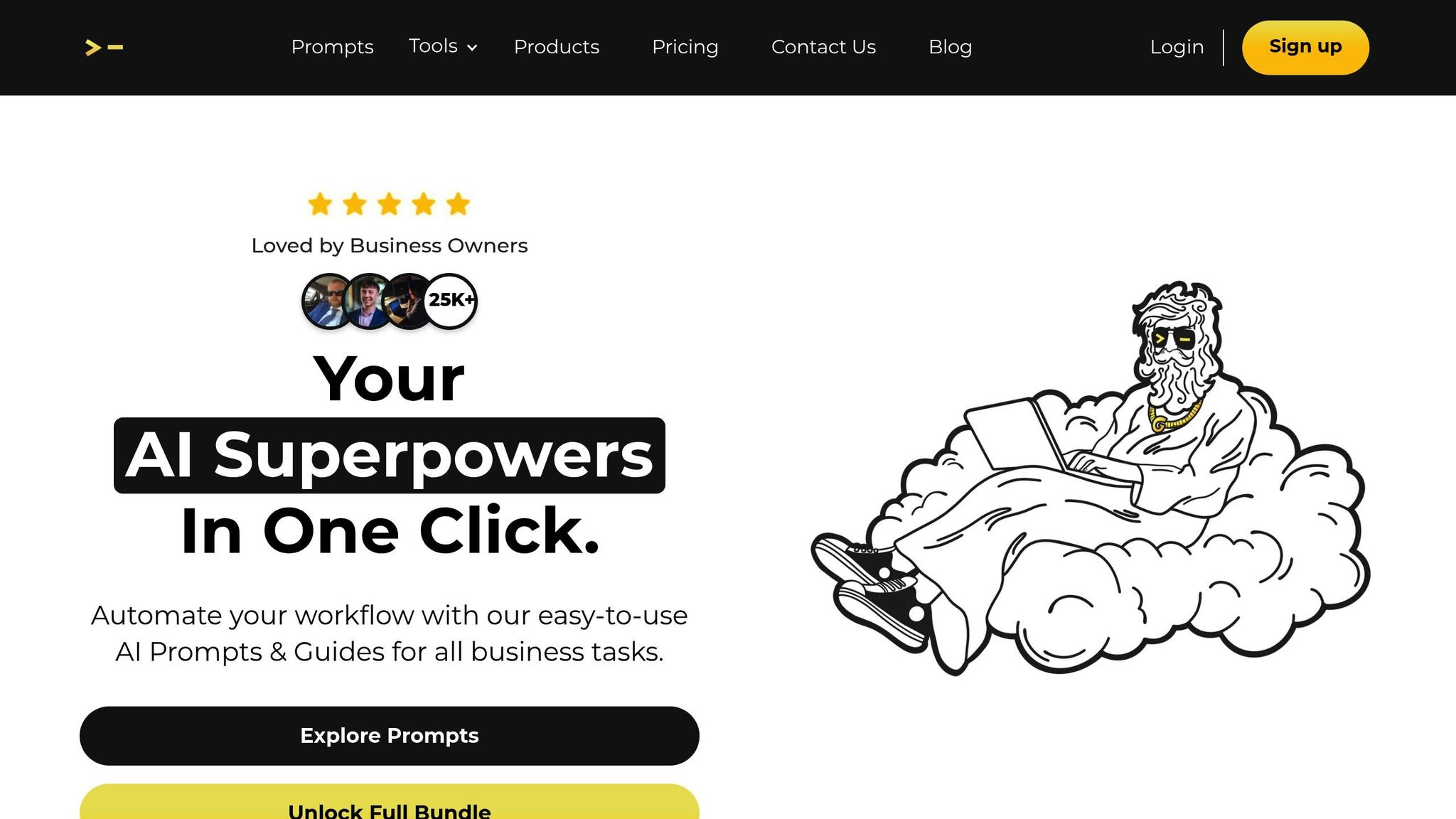
AI has transformed competitive analysis by automating data collection, identifying trends, and delivering actionable insights faster than ever. Here's how businesses can use AI to stay ahead:
AI enables businesses to shift from reactive strategies to proactive decision-making, ensuring they remain competitive in a fast-changing market. Keep reading to learn how to implement these tools effectively.

AI has the power to turn heaps of market data into clear, actionable insights. These technologies are the driving force behind real-time, accurate competitor intelligence.
Natural Language Processing lets computers dive into text, breaking it down to understand meaning and uncover relationships. By analyzing sources like news articles, social media posts, and customer reviews, NLP extracts key details and organizes them into insights. This helps businesses spot competitor strategies and gauge customer sentiment trends with ease.
Machine Learning is all about spotting patterns and making predictions. It equips systems to analyze data, predict trends, and even automate decision-making. Predictive analytics goes a step further, using statistical methods, data mining, and machine learning to forecast competitor actions and market changes. These tools allow businesses to stay ahead by identifying potential threats and opportunities before they’re widely visible.
AI-powered automation simplifies the process of gathering competitor data. By continuously monitoring competitor websites, tracking price changes, product launches, and marketing strategies, this technology ensures that your analysis is always up-to-date - all without the need for manual effort.
When combined, these technologies streamline data collection and provide the insights needed to make smarter, faster strategic decisions.
AI brings a sharper edge to competitive strategies by diving deep into pricing, marketing, and customer sentiment. It pieces together insights that guide businesses in staying ahead of their rivals.
AI keeps a constant eye on competitor pricing across various platforms, uncovering patterns like price changes, elasticity, and the best times to adjust prices. It factors in inventory levels, demand, and market events to suggest real-time price tweaks.
But pricing is just the beginning. AI also analyzes competitor product descriptions, marketing copy, and communication strategies. This helps identify gaps in positioning and spot untapped opportunities.
It doesn’t stop there. AI breaks down competitor discounting, bundling, and promotional tactics. This allows businesses to anticipate moves from their rivals and fine-tune their own strategies to stay competitive.
Once pricing insights are in place, AI shifts focus to refining marketing strategies and amplifying brand messaging.
AI dives into competitor content across channels, measuring engagement and uncovering patterns in messaging that resonate with audiences. It identifies areas where competitors excel and highlights SEO keyword opportunities that businesses can leverage.
By tracking changes in competitor messaging, AI helps businesses anticipate new campaigns, product launches, or shifts in market focus.
Beyond analyzing individual pieces of content, AI examines entire marketing strategies. It monitors advertising spend, pinpoints target audiences, and evaluates campaign performance across different platforms. This broader understanding helps businesses see where competitors are focusing their efforts and how resources are being allocated.
Meanwhile, AI also digs into customer sentiment to provide a more complete picture of how competitors are performing.
AI evaluates real-time customer sentiment by analyzing reviews, social media conversations, and support interactions. This reveals competitor strengths and weaknesses while tracking trends in brand perception.
For example, customer complaint analysis identifies recurring issues with competitor products or services. By understanding the common pain points, businesses can avoid similar pitfalls and even capitalize on these weaknesses. Often, this analysis uncovers unmet customer needs that could open doors to new opportunities.
Review platforms like Google, Yelp, and industry-specific sites offer another layer of insight. AI highlights which features or aspects of service customers care about most, helping businesses align their offerings to meet those expectations.
AI also tracks customer migration patterns, analyzing when and why customers switch from competitors. This intelligence sheds light on what drives customer decisions and offers businesses a chance to position themselves as a better alternative.
Choosing the right AI tool for competitive analysis can make a world of difference. The right tool doesn’t just automate competitor research - it delivers insights you can act on quickly and effectively.
When you're evaluating AI tools for competitive analysis, here are a few key factors to keep in mind:
Among the many options available, one tool that stands out is God of Prompt, known for its extensive prompt library and flexible integration capabilities.

God of Prompt is a unique platform offering over 30,000 AI prompts that help businesses supercharge their competitive analysis. It works with models like ChatGPT, Claude, and Gemini to generate insights that you can use right away. Instead of being a standalone software platform, it integrates directly with these AI models, making it a natural addition to your existing workflow.
The platform’s prompt bundles are designed to streamline competitive research. Whether you’re analyzing competitor websites, breaking down marketing strategies, or spotting gaps in market positioning, these bundles guide you step-by-step. This saves time and ensures you cover all the bases without having to build prompts from scratch.
Pricing Options: God of Prompt is accessible for businesses of all sizes. The free tier includes over 1,000 ChatGPT prompts and 100+ Midjourney prompts, letting you try out its capabilities with no upfront cost. For those looking for more, the Complete AI Bundle is available for a one-time payment of $150, offering lifetime access and unlimited updates.
Integration-Friendly Design: One of the standout features of God of Prompt is its seamless integration. Instead of forcing you to learn a new platform, it allows you to use prompts directly in tools like ChatGPT or Claude. This means you can enhance your analysis without disrupting your workflow.
Tailored for Your Needs: The prompts are fully customizable, so you can tweak them to fit your industry’s unique competitive landscape. Plus, the platform includes detailed guides to help users progress from basic competitor research to more advanced tasks like predictive analysis and strategic planning.
For businesses already using AI tools, God of Prompt offers an easy way to level up your competitive analysis. There’s no need to invest in complicated new software or spend time training your team - just plug it into your current setup and start gaining deeper insights right away.
An AI-driven workflow can take the guesswork out of competitive analysis by automating data collection and delivering insights you can act on immediately. By combining the right tools and strategies, you can turn raw information into a clear competitive edge.
Start by mapping out your competitive landscape, focusing on direct, indirect, and aspirational competitors. Think of this as the foundation of your analysis - structured and targeted.
A competitor matrix can help organize essential details like company size, target audience, pricing models, and key differentiators. Keep your initial focus manageable by limiting the analysis to 5–10 competitors.
Set clear priorities for what you’ll analyze. For instance:
Stay focused on areas that directly affect your growth. For example, if you’re a B2B SaaS company, tracking a competitor’s consumer product line won’t likely add value to your strategy.
Platforms like God of Prompt offer tailored prompts to help you map this landscape effectively. These prompts can even uncover indirect competitors or market positioning gaps that might not be immediately obvious.
Once you've identified what to track, the next step is setting up systems to gather data without constant manual input.
Set up automated alerts for major changes. Notifications for new product launches, pricing shifts, or significant content releases allow you to react faster - days or even weeks before you might notice otherwise.
While tools like RSS feeds and Google Alerts are a good starting point, AI-powered tools take it further. They can:
Adjust your data collection frequency to match your industry’s pace. For example:
The key is to avoid drowning in data. A steady stream of relevant and actionable information beats overwhelming daily reports every time.
Raw data is only useful if it leads to action. AI tools can help you identify patterns and create frameworks for responding effectively.
Develop pre-set response templates for common scenarios, like competitor pricing changes or new feature launches. For example, if a competitor rolls out a new feature, have criteria in place to decide whether it’s worth developing something similar.
Focus on high-impact insights. A competitor’s industry blog post might be interesting, but a new partnership with a major distributor could directly threaten your market share. Prioritize your efforts based on potential business impact.
Establish cross-functional workflows to share insights with the right teams:
Keep a record of your responses. Documenting what actions you took, how you responded to competitor moves, and the results achieved helps build a playbook for future situations. This institutional knowledge can prevent repeated missteps and refine your strategy over time.
Platforms like God of Prompt offer strategy templates to help structure your responses and ensure insights are turned into meaningful actions. These tools help streamline communication across your organization, making sure you’re not just gathering data but using it to make smarter business decisions.
These strategies are designed to predict competitor actions and uncover new opportunities in the market.
Machine learning can uncover patterns in historical data, offering insights into competitor behavior, market conditions, and trends to predict future actions with precision.
For example, seasonal trend analysis can highlight when competitors might launch new products or adjust their pricing. Advanced algorithms also go a step further, identifying market saturation points before traditional metrics catch on. They achieve this by analyzing factors like expansion rates, customer acquisition costs, and market penetration data.
To make this process more accessible, God of Prompt offers specialized prompts that simplify predictive analysis queries. These tools allow you to generate actionable forecasts from competitive data without needing deep technical expertise. These forecasts then become the foundation for more nuanced sentiment and strategic evaluations.
Understanding customer sentiment over time provides a deeper look into competitor strengths and weaknesses, moving beyond simple positive or negative feedback.
By using multi-platform sentiment tracking, AI can gather data from diverse sources like social media, review platforms, and support forums. This creates a complete picture of customer opinions. Tracking changes over time, rather than relying on isolated snapshots, reveals shifts in public perception that might otherwise go unnoticed.
Aspect-based sentiment analysis adds another layer by breaking feedback into specific product or service features. This granular approach helps refine your positioning by responding directly to competitor performance. Additionally, geographic sentiment analysis can reveal untapped opportunities by identifying regions where competitors may be falling short. These insights naturally lead to more targeted strategic planning, which ties into the next technique.
AI-powered scenario planning brings a new dimension to competitive analysis by simulating potential futures and testing strategic decisions.
Techniques like Monte Carlo simulations evaluate thousands of possible scenarios, taking into account variables like pricing, market conditions, and customer behavior. Game theory applications further enhance this by predicting how competitors might react to your moves, helping to minimize risks and avoid costly mistakes.
Market entry strategies and resource allocation can also benefit from these simulations. By testing various approaches, you can determine optimal investment levels and anticipate competitive responses. Advanced models even include uncertainty quantification and dynamic updates, ensuring your strategies evolve as new data becomes available.
The real power of scenario planning lies in combining AI's computational strength with human expertise. While AI handles the heavy lifting, human insight is crucial for interpreting results and applying them effectively.
For those new to this approach, God of Prompt offers scenario planning templates that streamline the process, making it easier to design strategic simulations without requiring advanced data science skills.
Using AI for competitive analysis isn't just about picking the right software. It's about employing strategies that turn raw data into meaningful insights. Without clear goals, even the most advanced tools can become little more than expensive data collectors.
The first step in effective AI-driven competitive analysis is knowing exactly what you're aiming for.
"Before diving in, clearly define what you want to achieve with AI-powered competitive analysis. Are you looking to identify new market opportunities, optimize pricing strategies, or improve product development? Having specific goals will help you choose the right AI tools and focus your efforts on the most relevant data." – McKinsey
Start by outlining specific business questions - like predicting competitor product launches or monitoring price wars - and establishing measurable KPIs. For example, companies implementing AI in October 2025 have found success using metrics such as weekly price variation by product category, social media share of voice compared to competitors, SEO ranking improvements for key terms, and the frequency of changes in competitor advertising campaigns.
It’s also important to develop a structured taxonomy that organizes your competitive landscape. Use specific keywords tied to your products, target demographics, and geographic markets. This framework ensures your AI tools stay focused on the most relevant data instead of drowning in irrelevant information.
Finally, strike a balance between automated data collection and human analysis.
AI is great at processing massive amounts of data and spotting patterns, but it’s the human touch that turns those patterns into actionable strategies. The best programs combine AI’s efficiency with human expertise.
Even with clear goals and a balance of AI and human input, there’s one more hurdle: too much data can lead to inaction. Overanalyzing results and waiting for perfect data can stall decision-making.
Tools like God of Prompt offer templates to help teams structure their analysis and avoid getting trapped in endless data loops. These frameworks encourage actionable conclusions, helping you move forward without falling into the trap of overthinking.
AI is reshaping how businesses approach competitive analysis. What once required time-consuming manual research has now been revolutionized by AI's ability to deliver faster, deeper, and more actionable insights. This shift isn't just about speed - it's about gaining a measurable edge in the marketplace.
AI takes competitive analysis to a whole new level. Beyond automating repetitive tasks, it ensures consistent accuracy, eliminating the risk of human error. For example, when tracking competitor pricing across hundreds or even thousands of products, AI maintains the same precision from start to finish.
What’s more, AI can uncover patterns and trends that human analysts might miss. By sifting through massive amounts of unstructured data - like social media chatter or patent filings - AI can predict competitor strategies, highlight emerging trends, and identify untapped market opportunities.
The cost-effectiveness of AI is another major advantage. While setting up AI tools and training your team requires an initial investment, the long-term savings in labor costs and the speed of decision-making often make it worthwhile within just a few months.
To harness these benefits, it’s essential to take a thoughtful approach to integrating AI into your competitive analysis processes. Start small - there’s no need to overhaul your entire system at once. Instead, begin with a specific use case and use accessible, template-based tools like God of Prompt to simplify the learning curve. This way, you can demonstrate immediate results while gradually scaling your efforts.
Prioritize data quality from the start. AI is only as effective as the data it analyzes, so take the time to define what information you need and ensure its accuracy. Regular audits are crucial to keep your AI tools working with relevant and up-to-date data.
Take an incremental approach to data collection. Starting with a focused dataset helps avoid information overload and builds your team’s confidence as they familiarize themselves with the technology.
Invest in training your team. Even the most advanced AI tools won’t deliver results if your team doesn’t know how to interpret and act on the insights. Focus on developing both technical skills and strategic thinking to make the most of your AI investments.
As the competitive landscape continues to evolve, AI will only grow more essential for staying ahead. Companies that act now to build these capabilities will position themselves as leaders, while others risk falling behind. AI isn’t just transforming competitive analysis - it already has. The real question is: will you be driving that transformation, or struggling to keep up?
Businesses can tap into AI tools like God of Prompt to enhance their competitive analysis by automating essential tasks and uncovering more detailed insights. Start by setting specific goals, such as evaluating competitors' strengths and weaknesses, identifying opportunities and threats (SWOT analysis), or benchmarking their strategies and content.
AI-powered prompts designed for market research, product evaluation, and digital strategy make it easier to collect and analyze data efficiently. These tools also allow for real-time tracking of competitors' actions, transforming traditional quarterly reviews into dynamic, continuous strategies. By weaving AI into your processes, you can make quicker, well-informed decisions and stay ahead in your industry.
When choosing AI tools for competitive analysis, prioritize those that align directly with your business objectives, whether that's enhancing market research, boosting SEO efforts, or optimizing social media performance. Look for tools that are not only affordable but also scalable and easy to integrate into your current workflows.
Another key consideration is the technical know-how required to set up and use the tools effectively. Opt for solutions that are user-friendly and come with clear, detailed documentation. This ensures you can get the most out of your investment without unnecessary complications.
AI-driven predictive analytics gives businesses the tools to analyze vast amounts of historical and real-time data, helping them identify patterns and predict future trends. Using advanced technologies like machine learning, natural language processing, and sentiment analysis, companies can better anticipate changes in the market, competitor strategies, and consumer behavior.
This means businesses can act proactively - whether it’s fine-tuning a product launch strategy or responding to new trends before others catch on. By relying on AI to guide decisions, companies can align their strategies with what’s coming next, staying ahead in the competitive landscape.





